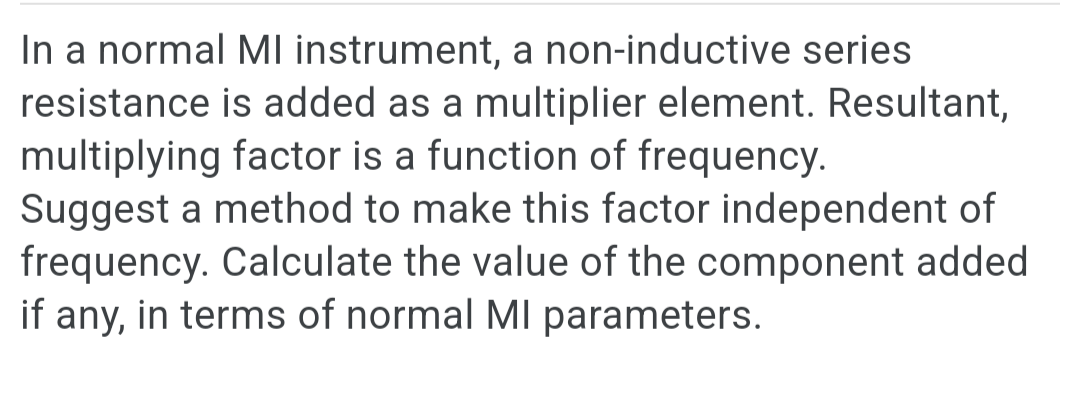In a normal MI instrument, a non-inductive series resistance is added as a multiplier element. The resultant multiplying factor is a function of frequency. Suggest a method to make... In a normal MI instrument, a non-inductive series resistance is added as a multiplier element. The resultant multiplying factor is a function of frequency. Suggest a method to make this factor independent of frequency. Calculate the value of the component added, if any, in terms of normal MI parameters.

Understand the Problem
The question is asking for a method to make the multiplying factor of a non-inductive series resistance independent of frequency in a normal MI instrument, along with a calculation of the component value based on normal MI parameters.
Answer
The capacitor value is given by $C = \frac{1}{2 \pi f R}$.
Answer for screen readers
The value of the component added, a capacitor, is given by:
$$ C = \frac{1}{2 \pi f R} $$
Steps to Solve
- Understanding the Multiplying Factor
The multiplying factor in a normal MI (Moving Iron) instrument is affected by the frequency of the input signal. To make this factor independent of frequency, we must analyze how resistance is determined in relation to frequency.
- Implementing a Compensation Method
To achieve independence from frequency, one approach is to use a feedback mechanism in the circuit. This would involve adding a capacitive component in parallel with the non-inductive series resistance.
- Calculating the Component Value
Using the formula for impedance in AC circuits, we can express total impedance. The non-inductive series resistance ($R$) and the capacitive reactance ($X_C$) must satisfy the following condition for independence of frequency:
$$ Z_{total} = R + \frac{1}{j \omega C} $$
At resonance, the total impedance can be simplified to: $$ Z = R , ( \text{assuming } j\omega C \text{ provides a compensatory effect} ) $$
Solving for $C$ gives: $$ C = \frac{1}{\omega R} $$
Where $\omega = 2 \pi f$ for frequency $f$.
- Final Component Value Calculation
Substituting for $\omega$: $$ C = \frac{1}{2 \pi f R} $$
Now, we can express the capacitor value in terms of the known parameters of the MI instrument.
The value of the component added, a capacitor, is given by:
$$ C = \frac{1}{2 \pi f R} $$
More Information
This approach provides a means to stabilize the multiplying factor across varying frequencies by compensating with a capacitive element. Understanding how inductance and capacitance interact in AC circuits is vital for this application.
Tips
- Confusing resistance with reactance; always differentiate between them in AC circuits.
- Forgetting to include frequency in the capacitor calculation; it is crucial since the value will change with frequency.